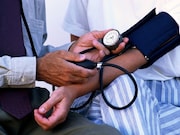Outcomes worse for some adverse cardiovascular events for participants in lowest-income sites
WEDNESDAY, July 31, 2019 (HealthDay News) — Receiving treatment at clinics in the lowest-income sites is associated with poorer blood pressure control and worse outcomes, according to a study published online July 31 in the Journal of the American Heart Association.
Andi Shahu, M.D., from Johns Hopkins Hospital in Baltimore, and colleagues examined the effect of socioeconomic context of study sites using data from the Antihypertensive and Lipid-Lowering Treatment to Prevent Heart Attack Trial (ALLHAT). Sites were stratified into income quintiles, and characteristics, blood pressure control, and cardiovascular outcomes were compared for ALLHAT participants in the lowest- and highest-income quintiles.
Overall, 2,169 participants (7.8 percent) received care in the lowest-income sites and 10,458 (37.6 percent) received care in the highest-income sites (quintiles 1 and 5, respectively). The researchers found that quintile 1 participants were less likely to achieve blood pressure control (odds ratio, 0.48) after adjustment for baseline demographic and clinical characteristics; in addition, they had greater all-cause mortality (hazard ratio, 1.25), heart failure hospitalizations/mortality (hazard ratio, 1.26), and end-stage renal disease (hazard ratio, 1.86) as well as lower angina hospitalizations and coronary revascularizations (hazard ratios, 0.70 and 0.71, respectively).
“These findings underscore the importance of measuring socioeconomic context in randomized clinical trials and suggest the need to invest in strategies to mitigate socioeconomic disparities and achieve more equitable outcomes in the care of hypertension,” the authors write.
One author disclosed financial ties to the pharmaceutical, medical device, and health technology industries.
Copyright © 2019 HealthDay. All rights reserved.








